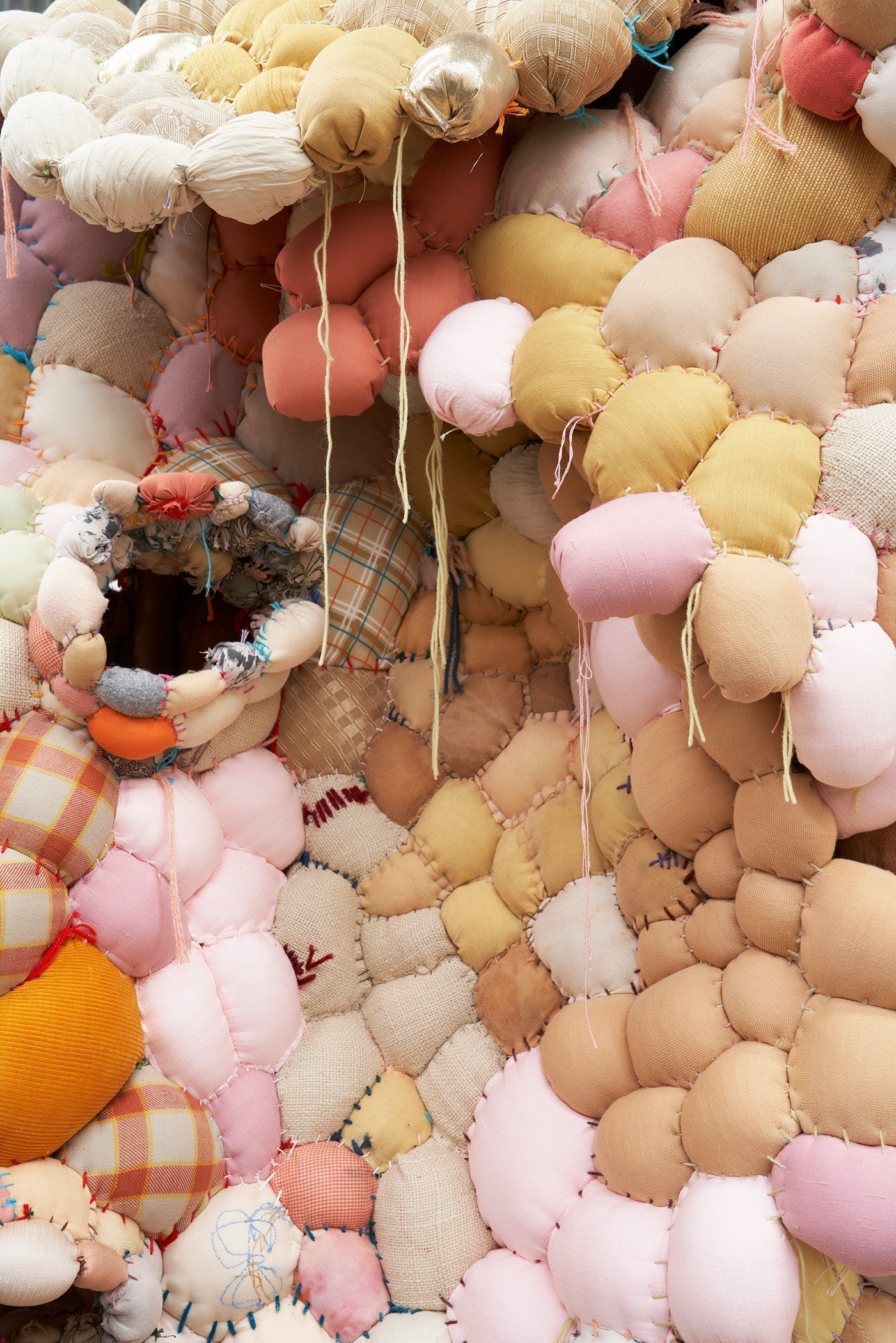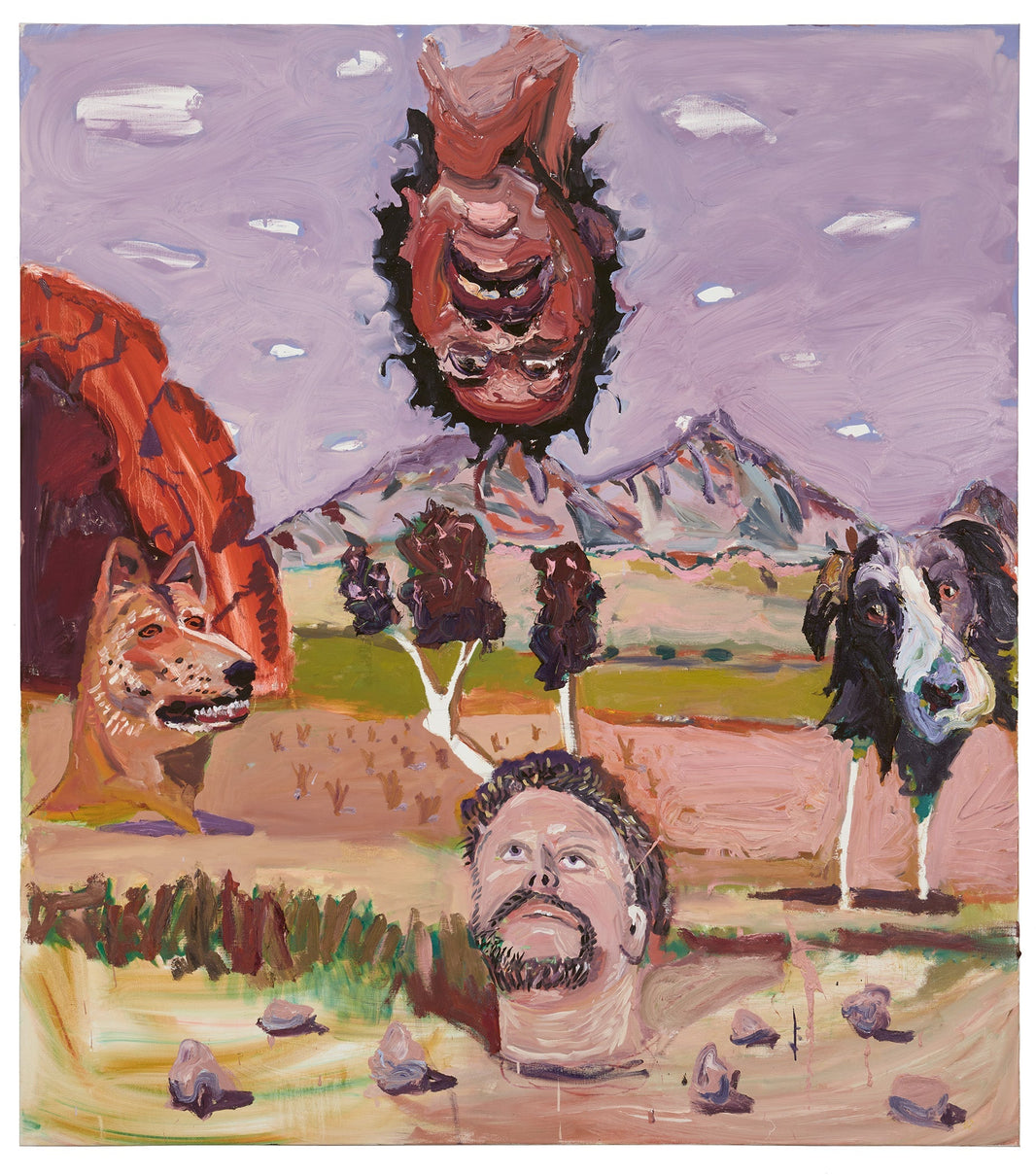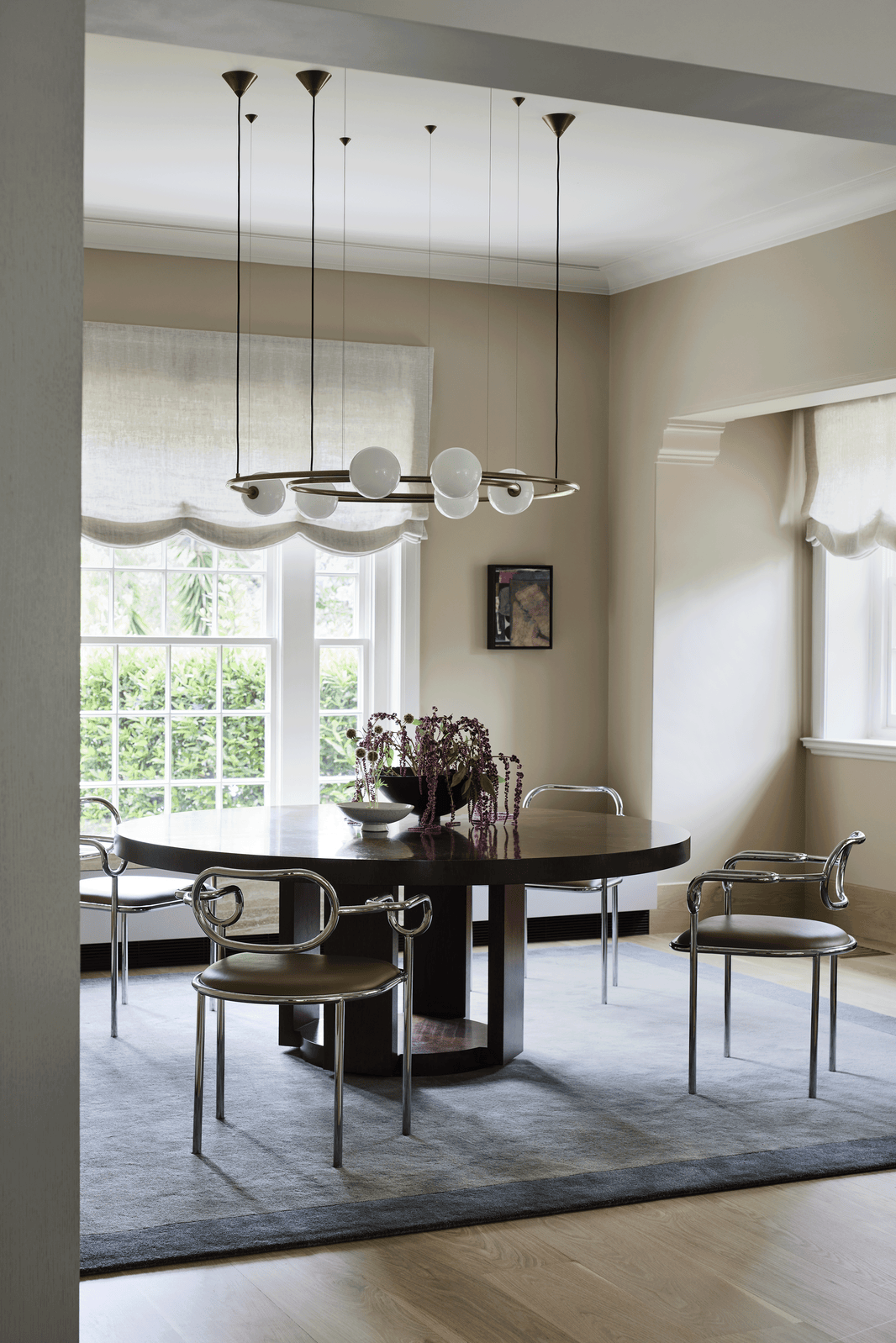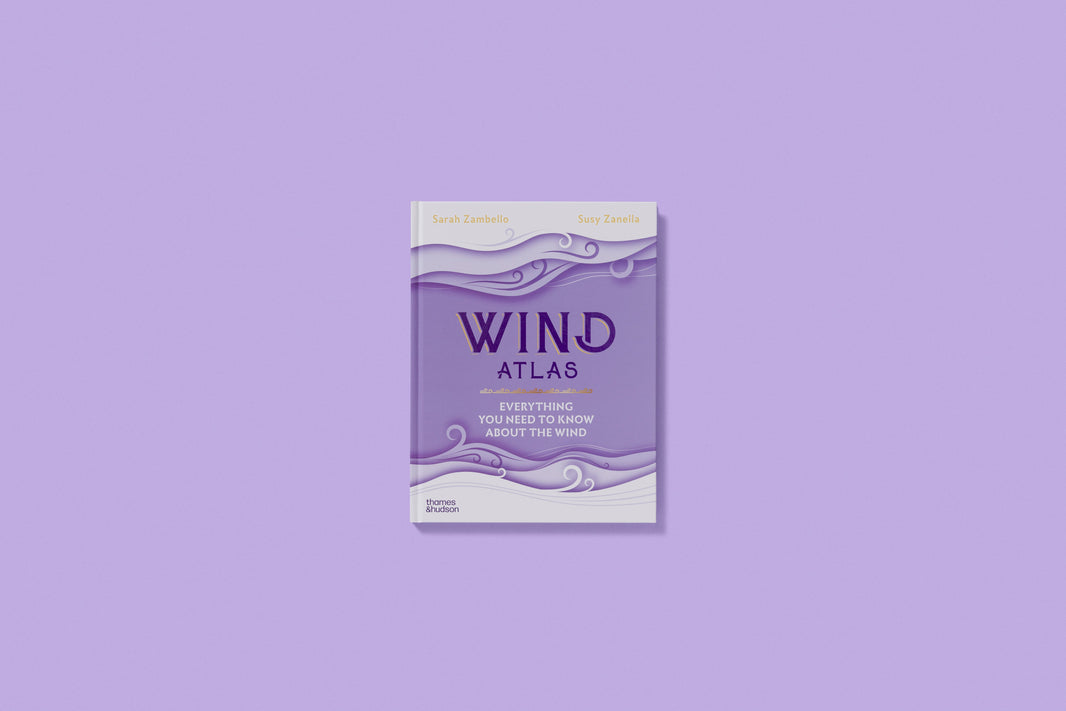Take a sneak peak into Textiles x Art
Explore the vibrant resurgence of textiles and art in this excerpt from Textiles x Art by Ramona Barry and Beck Jobson, available November 4.

Kasia Töns, Detail of Panopoly II, 2023, Assorted old fabrics, old pillow stuffing, cardboard tubes, letterbox poles, red oak, wheels, hemp rope, tin cans, plywood and tung oil, hand stitched, 300 x 150 x 160 cm (approx)
From cradle to grave, textiles surround us. Woven, knitted, knotted, sewn, felted, quilted, patched, printed and dyed, they are carriers of culture that deeply engage our senses and memories across borders and decades. Textiles of all kinds create literal and metaphoric links between the personal and political, from local neighbourhoods to globalised economies. They reach across the oceans and into all spheres of human existence, and are found everywhere from intimate interiors to the most cutting-edge medical research laboratories. Textiles are a way to tell stories, spark conversations and make powerful artistic statements. Textiles × Art dives into the role textiles increasingly play in the practices of artists who are tackling big issues like social justice, sustainability and cultural identity.
Our lifelong relationship with textiles extends far beyond what we wear. Within domestic spaces, we express ourselves through pattern, colour and thread count. Publicly, flags wave in fealty, festivity and protest. At their best, textiles provide comfort, convey style and communicate culture. At their worst, they represent labour, waste and unsustainable consumption. So pervasive are textiles that, for many years and for most people, they have been rendered almost invisible, a non-event, an overlooked and undervalued aspect of the everyday. However, it is this ‘ordinariness’ that provides textiles with their extraordinary power to connect people to place, generation to generation and culture to culture.
Historically, textiles have held a lowly position within the Western art canon. For centuries, high art was overwhelmingly the domain of white men with lofty ideals and ‘important’ perspectives. Beyond the world of painting, it was executed in hard materials – bronze, concrete and steel. In opposition to this, textiles were categorised as feminine/soft/domestic/craft; their materials and processes ignored and undervalued. Unsurprisingly, in many instances these views about textiles extended beyond geographic and cultural borders and became almost universal.
In the mid-20th century, the revolutions of modernity – first wave feminism, the Bauhaus school’s elevation of function and form, and the passion for the handmade that permeated the counter cultural zeitgeist – saw textiles being championed. However, the consumerism that dominated subsequent decades rejected these values, favouring new technologies and a clinical hardness in contemporary art. Textiles were relegated again to the world of domestic design and fashion, no longer valued in the high-octane world of ‘art as commodity’ that defined the late 20th and early 21st centuries.

John K Raustein, Installation view of When Everything Falls into Place, Kunstnerforbundet, Oslo, 2019, textiles, filling wadding and wood
Changes in cultural landscape are often mirrored by a cyclic ‘rediscovery’ and revaluation of the relevance of textile art by the broader art industry. Now, after decades in the ‘high art’ wilderness, textiles are finding their way back into the practices of artists and onto the walls of acclaimed art galleries. In a technologically complex and increasingly polarised world, artists, audiences and curators are returning to textiles to amplify traditionally marginalised perspectives and reconnect with the tangible humanity of the handmade.
Over the past five years, significant textile artists, including Sheila Hicks, Olga de Amaral, Faith Ringgold and Anni Albers, have been showcased in major solo retrospectives. In a top-ten listicle for Art in America, journalist Glenn Adamson declared 2024 the year of the ‘high-fiber diet’, citing major global exhibitions showcasing textiles in both traditional and radical forms around the world. In 2024, Artnet announced Liz Collins, a major textile-based American artist, as one of the top seven artists to appear at that year’s coveted Venice Biennale, an event which increasingly sees textile artists like Chiharu Shiota and Faig Ahmed selected to represent their countries. At Art Basel Hong Kong in 2024, galleries presented artists from across generations and geographies previously relegated to the periphery of the artworld to audiences and collectors who were hungry for exciting and authentic new work. Significant international exhibitions like the Barbican’s Unravel: The Power and Politics of Textiles in Art(2024) showcase the changing concerns of artistsand audiences by specifically selecting artists who are using textiles to ‘challenge power structures and reimagine the world’.
But why now? What has shifted? Art has always mirrored contemporary culture, and while it has been a slow, and often less visible path to its current success, textiles have been on an upward trajectory for the past twenty years. The rise of DIY culture in the early 2000s paralleled renewed vigour in political and social movements that advocated queer inclusivity, new-wave feminism, climate action and responses to increasingly polarised political divides. A new counterculture emerged, supercharged by social media, which positioned textiles once again as a significant tool for artistic discourse and radical action. This era of ‘craftivism’ extended global access and interest in a new generation of artists who are using embroidery, knitting and sewing to create subversive textile artworks that shatter previous ‘cottage craft’ associations.
The chequered history of industrialised cloth is also a critical site for examining the links between trade, labour and oppression. The often-violent intersections of this industrial history with more traditional, sociocultural textile production provides a meaningful context for artists seeking to interrogate the lasting impacts of colonisation on cultural practice and identity. These artists use textiles to confront colonial legacies, reclaim cultural narratives and envision decolonised futures through the unifying language of textile tradition. The revival of textile processes, palettes and motifs are a vital mechanism for their reclamation of Indigenous knowledge systems.

Carmen Mardonez, Twisted Intentions, 2021, textile sculpture on pillows and hand-embroidered bed sheet, 66 x 50.8 x 40.6 cm
Textiles now occupy a unique position within contemporary art, serving as a bridge between tradition and innovation. Embodying centuries of cultural history, they offer a dynamic platform for analytical and material engagement with current issues across identity, environment and sociopolitical commentary. By intertwining complex critiques of the human condition within familiar and accessible processes, textiles are appealing to a growing group of contemporary artists who seek to dissolve boundaries, challenge conventions and reveal hidden realities.
Beyond the artists featured in this book, there is an ever-growing legion of artists who are blending ancient traditions, cultural heritage and contemporary concerns. Kayla Mattes and Erin M Riley use handwoven tapestry to create highly detailed figurative works that respond to the digital environment of doom scrolling, memes and sexting culture. Diedrick Brackens uses hand-dyed cotton to acknowledge the brutal history of the African American experience while weaving remarkably tender imagery in woven double-cloth wall works that explore allegory and queer autobiographical narratives. Jeffrey Gibson, the first Native American artist to have a solo presentation at the US Pavilion in the Venice Biennale, features traditional beading throughout his practice in a bold reclamation and celebration of Native and queer narratives. His 2024 Venice Biennale centrepiece, ‘WE HOLD THESETRUTHS TO BE SELF EVIDENT’, was an immersive tour de force of Indigenous style, creativity and resistance. Even the quilt has been reimagined by artists like Bisa Butler and Dawn Williams Boyd, who reframe the Gee’s Bend tradition in arresting portraits that celebrate Black narratives and layer meaning through their use of African wax-print patterned fabrics.
Textiles are again enthralling audiences, reflecting an expanded field of makers and curators– artists of ambitious vision, skill and unique and relevant perspectives. This book celebrates their contributions, exploring the diverse ways in which textiles act as both a core medium and a tool for creative expression. With an almost endless subject and a long list of potential artists, our approach was deceptively simple. What works excite us? Which artists challenge us as curators, writers and makers? What textile artworks unlock a uniquely powerful way of communicating complex concerns?

Kasia Töns, Ronisconi, 2024, digital photographic print featuring hand-sewn mask, 106 x 91.5 cm
Early on, we knew we had questions. We reached out to forty-four artists from across the globe, and asked about their techniques, conceptual concerns, localities and material choices. Their responses were overwhelmingly generous – an open invitation into their practices, shared with enthusiasm and thoughtfulness. We avoided the headline acts – Sheila Hicks, Magdalena Abakanowicz, Lenore Tawney, Vanessa Barragão – as there is already a deluge of text supporting and celebrating their work. Our driving goal was to take a global snapshot, identifying the common concerns, the ‘threads’ that connect artists worldwide in what feels like a significant moment for textiles in contemporary art practice.
Many of the artists within this book have specifically accessed the rich material language of textiles to explore gender norms, critique societal structures, confront cultural heritage and articulate the ongoing impacts of colonisation. Artists like Paolo Arao, Miguel Arzabe and Paula do Prado weave mysticism, technical traditions and cultural critique into their textile compositions. Troy-Anthony Baylis and Kait James skew Australia’s colonial history with pop-culture tropes and razor-sharp parodies that centre Indigenous experience and radically reposition settler narratives.
Sustainability is examined from personal and global perspectives by many artists. Some like Tamara Kostianovsky, Kwaku Yaro and Delphine Dénéréaz focus on the ecological aspects of textiles, finding meaning in the inventive reinvention of waste materials as an antidote to mass consumption, and creating works that act as an urgent protest against the devastating environmental impacts of late-stage capitalism. Others like Phong Chi Lai and Kay Abude trace and address the legacies and currencies of migrant labour and exploitation, while Arko, Signe Emdal and Ana Teresa Barboza use textiles as a geolocator, exploring the use of fibres connected to place, and plant and earth-based dyes, to connect them back to cultural practices, and ancestral and adopted homes.
As textile techniques often exist outside the patriarchal, hierarchical confines of traditional fine art, they can offer a kind of liberation for artists and audiences alike, evoking highly personal connections. Within Textiles × Art, artists like Ema Shin and Louise Meuwissen use this freedom to beguile and critique in equal measure, making bejewelled works that examine conventions of gendered beauty, while Kasia Töns’s textile shelters reflect on the shared responsibilities and broader meaning of caregiving in the Anthropocene era. Andrea V Wright and Hannah Gartside’s fashion roots manifest within their use and context of cloth. Wright uses drape in a metaphoric commentary of body politics, while Gartside centres the emotional resonance and charged context of feminised garments within her kinetic and anthropomorphic sculptures.

Hannah Gartside, Installation view of The Sleepover, 2018–2019, the Fantasies series, Ararat Gallery Tama, 2019, found nighties and slips, found fabric and cotton ribbon, millinery wire, thread, 670 x 280 x 210 cm
Inherited textile techniques, most often passed down matrilineally and coded within queer and gender-nonconforming communities, are a rich source for contemporary textile artists who interrogate gender through their material and conceptual practices. Artists like Emma Buswell and Jade Yumang reclaim domestic and colonised craft techniques as a shorthand cypher to simultaneously deconstruct hackneyed stereotypes while finding liberation and power in their subversive reassignment.
Many artists used the word ‘unlocked’ to describe the impact of finding their voice through textile technique, referencing its power as an authentic conceptual and material language. For some, textiles act as a tool that complements and enriches their fine-art practices, providing new dimensions to existing forms like painting and sculpture. Troy Emery, John K Raustein, Jen P Harris and Lindsay Mapes use textiles to push the boundaries of their chosen forms and deepen their conceptual engagement with the audience. For others, such as Jacqueline Stojanović and Elise Cakebread, textiles stand at the very forefront of their practice, representing the coremedium through which they articulate their work –a celebration of material culture that uses structure,pattern and textile heritage as its own language.
All, however, have found meaning in textile process – mixing ancient methods with contemporary viewpoints, materials and technology, and using the uniquely fluid conceptual 12 Textiles x Art and material capacities of textiles, and their shared humanity and unique ability to collapse time and space, to create transportive works that expand our understanding of the world and each other. This book is both a celebration and a call to action – an invitation to engage with the profound possibilities of textile art. As we navigate a world of rapid change and increasing complexity, these artists remind us that art, like textiles, is woven from the threads of tradition, innovation and shared humanity. Together, they inspire us to imagine a more thoughtful, connected and creative future.
Textiles x Art by Ramona Barry and Beck Jobson is available November 4.






